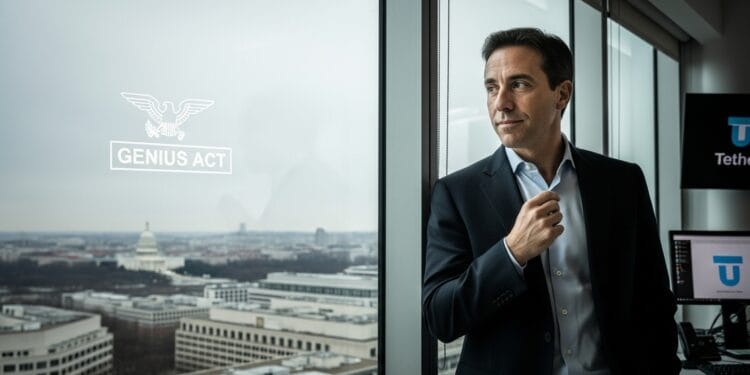A fresh breeze is blowing through the stablecoin world, particularly here in the United States. For years, Tether has operated as a global force, its USDT token a bedrock for many in the crypto space. Now, it appears the company is making a decisive push into the American market, a move that feels both natural and, perhaps, a little overdue.
- Tether is expanding into the US market, aiming to offer a new stablecoin tailored for institutional clients.
- The GENIUS Act, recently signed into law, establishes a regulatory framework for stablecoins in the US, impacting Tether’s operations.
- Tether is prioritizing transparency, including a full audit, as it enters the regulated US market.
This shift comes right on the heels of a significant legislative moment. President Trump recently signed the GENIUS Act into law. This new bill aims to bring a clear regulatory framework to stablecoins in the US, setting the stage for what could be a very different playing field.
Paolo Ardoino, Tether’s CEO, spoke with Bloomberg Television recently. He confirmed what many have suspected. “We are well in progress of establishing our U.S. domestic strategy,” Ardoino stated. It sounds like the gears are turning, and they’re turning quickly.
This isn’t a spur-of-the-moment decision, mind you. Back in April, Ardoino had already hinted at these plans to The Block. He mentioned a new US-based stablecoin, one specifically designed for institutional clients. Think big banks, large investment firms, and other financial giants looking to move serious capital.
Why a new stablecoin, you might ask, when USDT already holds a commanding lead? USDT, with its $162 billion market capitalization, is the world’s largest stablecoin. But this new offering, Ardoino suggests, would focus on faster settlements. For institutions, every second saved can mean millions of dollars, so speed is a powerful draw.
Ardoino didn’t just drop hints. He promised an announcement. “That is well underway,” he said, referring to their US institutional market plans. He expects to share more details in the “next couple of months.” So, we won’t have to wait long to see the full picture.
Now, Tether has faced its share of questions over the years. The biggest one has always revolved around its reserves. The company has provided quarterly attestations, signed by BDO Italia, but a full, independent audit has remained elusive. This has been a point of contention for many observers.
It seems Tether is taking steps to address this. Just last month, they brought in Simon McWilliams as their new chief financial officer. His main mission? To lead the charge toward securing that full audit. Ardoino himself has called obtaining a review from a Big Four audit firm (Deloitte, EY, PwC, or KPMG) a “top priority.” It’s a clear signal they understand the importance of transparency, especially as they look to enter a regulated US market.
A New Regulatory Chapter
The GENIUS Act is a game changer for stablecoins in the US. Ardoino was even present when President Trump signed the bill in Washington. This legislation creates a federal framework for fiat-pegged tokens. It’s the first major crypto framework to become US law, which is a big deal.
What does the GENIUS Act actually do? It requires stablecoins to be fully backed by US dollars or other similarly liquid assets. This means for every digital token, there should be a real dollar (or something very close to it) sitting in a bank account. It also mandates annual audits for issuers with a market capitalization over $50 billion. This will certainly apply to Tether and its new US stablecoin. The law also sets guidelines for foreign issuance, adding another layer of clarity.
This new regulatory environment will also bring increased competition. Traditional banks, the very institutions Tether aims to serve, are making their own stablecoin plans. Companies co-owned by financial giants like JPMorgan, Bank of America, Citigroup, and Wells Fargo are reportedly in early talks for a joint stablecoin venture. It’s a classic case of the old guard stepping onto the new turf.
Ardoino acknowledges this. He told Bloomberg that these traditional competitors “might be better than us in the short term in the United States just because it’s a new market for us.” That’s a candid admission, isn’t it? But he quickly added a caveat. Tether, he believes, has “better technology” and “a much better understanding of this market than anyone else.” It’s a bold claim, but one that speaks to Tether’s long experience in the crypto world.
The question of going public, like competitor Circle did, also came up. Ardoino’s answer was direct: Tether isn’t interested. They seem content to remain a private entity for now, focusing on their core business and this new US expansion.
Looking Ahead
So, what does this all mean for the average crypto enthusiast, or even just the curious observer? It means that stablecoins, long a quiet workhorse of the crypto economy, are stepping into the mainstream spotlight. Regulation brings both challenges and opportunities. For Tether, it means a chance to legitimize its operations further in a critical market, but also to face direct competition from some of the world’s largest financial players.
The coming months will be telling. We’ll watch for Tether’s announcement about their institutional stablecoin. We’ll also keep an eye on their audit progress. And we’ll certainly see how the traditional banks fare in their own stablecoin ventures. The stablecoin landscape is shifting, and it promises to be a fascinating ride.

















